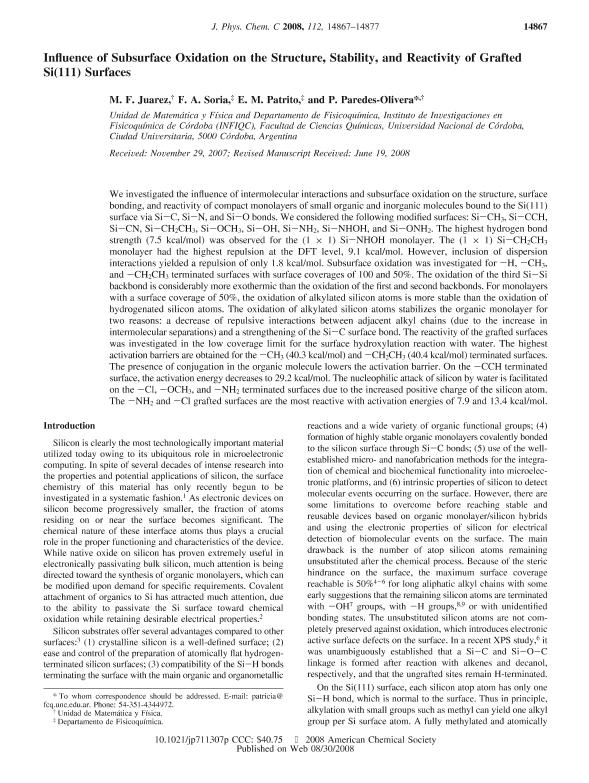Mostrar el registro sencillo del ítem
dc.contributor.author
Juarez, Maria Fernanda

dc.contributor.author
Soria, Federico Ariel

dc.contributor.author
Patrito, Eduardo Martin

dc.contributor.author
Paredes Olivera, Patricia

dc.date.available
2020-09-15T19:49:46Z
dc.date.issued
2008-09
dc.identifier.citation
Juarez, Maria Fernanda; Soria, Federico Ariel; Patrito, Eduardo Martin; Paredes Olivera, Patricia; Influence of subsurface oxidation on the structure, stability, and reactivity of grafted Si(111) surfaces; American Chemical Society; Journal of Physical Chemistry C; 112; 38; 9-2008; 14867-14877
dc.identifier.issn
1932-7447
dc.identifier.uri
http://hdl.handle.net/11336/114040
dc.description.abstract
We investigated the influence of intermolecular interactions and subsurface oxidation on the structure, surface bonding, and reactivity of compact monolayers of small organic and inorganic molecules bound to the Si(111) surface via Si-C, Si-N, and Si-O bonds. We considered the following modified surfaces: Si-CH3, Si-CCH, Si-CN, Si-CH2CH3, Si-OCH 3, Si-OH, Si-NH2, Si-NHOH, and Si-ONH2. The highest hydrogen bond strength (7.5 kcal/mol) was observed for the (1 × 1) Si-NHOH monolayer. The (1 × 1) Si-CH2CH3 monolayer had the highest repulsion at the DFT level, 9.1 kcal/mol. However, inclusion of dispersion interactions yielded a repulsion of only 1.8 kcal/mol. Subsurface oxidation was investigated for -H, -CH3, and -CH2CH 3 terminated surfaces with surface coverages of 100 and 50%. The oxidation of the third Si-Si backbond is considerably more exothermic than me oxidation of the first and second backbonds. For monolayers with a surface coverage of 50%, the oxidation of alkylated silicon atoms is more stable than the oxidation of hydrogenated silicon atoms. The oxidation of alkylated silicon atoms stabilizes the organic monolayer for two reasons: a decrease of repulsive interactions between adjacent alkyl chains (due to the increase in intermolecular separations) and a strengmening of the Si-C surface bond. The reactivity of the grafted surfaces was investigated in the low coverage limit for the surface hydroxylation reaction with water. The highest activation barriers are obtained for the -CH3 (40.3 kcal/mol) and -CH 2CH3 (40.4 kcal/mol) terminated surfaces. The presence of conjugation in the organic molecule lowers the activation barrier. On the -CCH terminated surface, the activation energy decreases to 29.2 kcal/mol. The nucleophilic attack of silicon by water is facilitated on the -Cl, -OCH 3, and -NH2 terminated surfaces due to the increased positive charge of the silicon atom. The -NH2 and -Cl grafted surfaces are the most reactive with activation energies of 7.9 and 13.4 kcal/mol.
dc.format
application/pdf
dc.language.iso
eng
dc.publisher
American Chemical Society

dc.rights
info:eu-repo/semantics/openAccess
dc.rights.uri
https://creativecommons.org/licenses/by-nc-sa/2.5/ar/
dc.subject
Silicon
dc.subject
Subsurface Oxidation
dc.subject
Surface Modification
dc.subject
Ab Initio
dc.subject.classification
Físico-Química, Ciencia de los Polímeros, Electroquímica

dc.subject.classification
Ciencias Químicas

dc.subject.classification
CIENCIAS NATURALES Y EXACTAS

dc.title
Influence of subsurface oxidation on the structure, stability, and reactivity of grafted Si(111) surfaces
dc.type
info:eu-repo/semantics/article
dc.type
info:ar-repo/semantics/artículo
dc.type
info:eu-repo/semantics/publishedVersion
dc.date.updated
2019-05-06T14:17:52Z
dc.identifier.eissn
1932-7455
dc.journal.volume
112
dc.journal.number
38
dc.journal.pagination
14867-14877
dc.journal.pais
Estados Unidos

dc.journal.ciudad
Washington DC
dc.description.fil
Fil: Juarez, Maria Fernanda. Consejo Nacional de Investigaciones Científicas y Técnicas. Centro Científico Tecnológico Conicet - Córdoba. Instituto de Investigaciones en Físico-química de Córdoba. Universidad Nacional de Córdoba. Facultad de Ciencias Químicas. Instituto de Investigaciones en Físico-química de Córdoba; Argentina
dc.description.fil
Fil: Soria, Federico Ariel. Consejo Nacional de Investigaciones Científicas y Técnicas. Centro Científico Tecnológico Conicet - Córdoba. Instituto de Investigaciones en Físico-química de Córdoba. Universidad Nacional de Córdoba. Facultad de Ciencias Químicas. Instituto de Investigaciones en Físico-química de Córdoba; Argentina
dc.description.fil
Fil: Patrito, Eduardo Martin. Consejo Nacional de Investigaciones Científicas y Técnicas. Centro Científico Tecnológico Conicet - Córdoba. Instituto de Investigaciones en Físico-química de Córdoba. Universidad Nacional de Córdoba. Facultad de Ciencias Químicas. Instituto de Investigaciones en Físico-química de Córdoba; Argentina
dc.description.fil
Fil: Paredes Olivera, Patricia. Consejo Nacional de Investigaciones Científicas y Técnicas. Centro Científico Tecnológico Conicet - Córdoba. Instituto de Investigaciones en Físico-química de Córdoba. Universidad Nacional de Córdoba. Facultad de Ciencias Químicas. Instituto de Investigaciones en Físico-química de Córdoba; Argentina
dc.journal.title
Journal of Physical Chemistry C

dc.relation.alternativeid
info:eu-repo/semantics/altIdentifier/url/http://pubs.acs.org/doi/abs/10.1021/jp711307p
dc.relation.alternativeid
info:eu-repo/semantics/altIdentifier/doi/https://doi.org/10.1021/jp711307p
Archivos asociados
